FAQ’s
How Can We Help You?
1Do you have to clean the room first for MoonBeam™3?
Yes! While there is evidence in studies that we have efficacy even without cleaning, it is always stipulated to clean first. UVC disinfection is an additive technology, action taken in addition to normal cleaning, and that is why it has to be as easy and fast as possible.
2What pathogens does MoonBeam™3 kill and what is the time frame for each?
MoonBeam™3 has been tested on a variety of organisms, with the most difficult pathogen being C.Diff spores. Generally, three minute cycles kill vegetative organisms and three minutes kills CDiff. See the test and clinical results pages. In summary, C.Diff, MRSA, Staphylococcus aureus, Bacillus atrophaeus, MS Phage2, E-coli, Pseudomonas aeruginosa, have been tested a varying times and distances.
3What is UVC?
UVC is an acronym for ultraviolet light in the C spectrum. Ultraviolet light can be UVA, UVB or UVC. The important aspect is that UVC is the shortest wavelength of the three and holds the keys to almost all of the disinfection power.
UV-A is long wave UV and is not blocked by glass, commonly used in black lights and tanning salons, and potential risks are premature skin aging, carcinogen
UV-B is mostly solar and is absorbed by the earth’s ozone layer and blocked by glass. Common use is curing and risks include sunburn and potential skin cancer
UV-C is short wave UV, which includes germicidal ultraviolet used for air, surface, and water treatment. 100% blocked by “glass”. Risks include skin redness and eye irritation.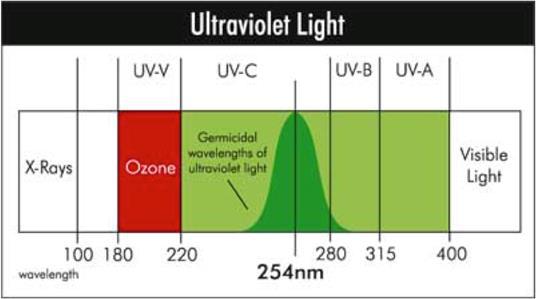
UVC wavelength is 100-280 nm - Our systems generate UVC around a very specific frequency of 253.7 nanometers due to the use of mercury vapor as the generation medium. This is important. The capability to generate ozone as a byproduct of the creation of ultraviolet light is well-defined. When light sources are capable of generating the region of light centered around 185nM wavelength, ozone is generated where the bulb glass interacts with ambient air. In some applications, ozone generation is desirable, and bulb manufacturers can specifically make glass to maximize ozone production. However, in many cases ozone generation is unwanted and this is certain in the Moonbeam3 and SKY applications. The requirement to avoid generating ozone is understood and specific dedicated action is taken to avoid it. The solution is widely known and employed. To block ozone generation, bulbs are manufactured from a doped quartz material that contains, by design, impurities. Bulb glass made this way entirely absorbs the region of light around 185nM wavelength. As a result, while there is a trace of air/glass interaction smell, such as from UVC interacting with microscopic particles suspended in the air, there is no measurable ozone generated.
UVC penetrates deoxyribonucleic acid (DNA) or ribonucleic acid (RNA) of microorganisms, disrupts the cell’s genetic material and impedes reproduction. When microbes are irradiated with the appropriate dosage of UVC, affected cells are considered “dead” because they cannot replicate.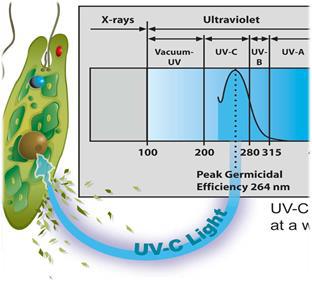
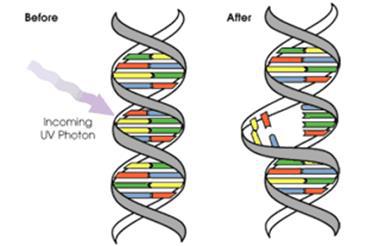
Understanding the background on UVC, what it is, and how it works, there is an important characteristic to grasp. The chart below shows the power of UV as a disinfectant.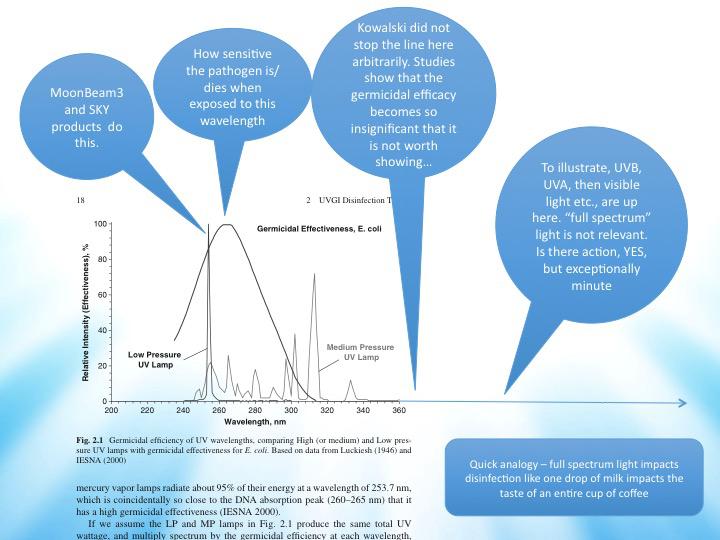
UV-A is long wave UV and is not blocked by glass, commonly used in black lights and tanning salons, and potential risks are premature skin aging, carcinogen
UV-B is mostly solar and is absorbed by the earth’s ozone layer and blocked by glass. Common use is curing and risks include sunburn and potential skin cancer
UV-C is short wave UV, which includes germicidal ultraviolet used for air, surface, and water treatment. 100% blocked by “glass”. Risks include skin redness and eye irritation.

UVC wavelength is 100-280 nm - Our systems generate UVC around a very specific frequency of 253.7 nanometers due to the use of mercury vapor as the generation medium. This is important. The capability to generate ozone as a byproduct of the creation of ultraviolet light is well-defined. When light sources are capable of generating the region of light centered around 185nM wavelength, ozone is generated where the bulb glass interacts with ambient air. In some applications, ozone generation is desirable, and bulb manufacturers can specifically make glass to maximize ozone production. However, in many cases ozone generation is unwanted and this is certain in the Moonbeam3 and SKY applications. The requirement to avoid generating ozone is understood and specific dedicated action is taken to avoid it. The solution is widely known and employed. To block ozone generation, bulbs are manufactured from a doped quartz material that contains, by design, impurities. Bulb glass made this way entirely absorbs the region of light around 185nM wavelength. As a result, while there is a trace of air/glass interaction smell, such as from UVC interacting with microscopic particles suspended in the air, there is no measurable ozone generated.
UVC penetrates deoxyribonucleic acid (DNA) or ribonucleic acid (RNA) of microorganisms, disrupts the cell’s genetic material and impedes reproduction. When microbes are irradiated with the appropriate dosage of UVC, affected cells are considered “dead” because they cannot replicate.


Understanding the background on UVC, what it is, and how it works, there is an important characteristic to grasp. The chart below shows the power of UV as a disinfectant.

4Is MoonBeam™3 effective on soft surfaces, like privacy curtains?
The short answer is no, ultraviolet energy in the C spectrum cannot penetrate the material. UVC can disinfect the very outermost surface of a curtain, for example, but it has no penetrating capability, so is not a robust method and is not recommended.
5Are there any compatibility issues with UV? What kind of damage can happen?
It is most useful to know that we generate the greatest germicidal activity with the least material incompatibility due to the directionality of dose that we are applying, the dispersing of that dose (wide coverage - and no over-dosing of nearby objects), the speed with which we apply the dose, and the highly monochromatic nature of our sources. If there is any negative ramification of our technique it is very unlikely to be any mechanical ramification. For better and worse, UVC is a surface only technology.
6What are the power requirements to use the devices? Competitive device?
MoonBeam™3 draws 4 amps at 110 volts, roughly 400 watts - think (4) 100 watt bulbs.
Competition can draw 12+ amps at 110 volts, roughly 1300 watts - think 13 to 15, 100 watt bulbs.
Competition can draw 12+ amps at 110 volts, roughly 1300 watts - think 13 to 15, 100 watt bulbs.
7Green certifications
There is no green certification. We comply with RoHS and Reach.
8Mercury content in the bulbs
The bulbs in our systems use the most effective means of UVC generation - excited mercury vapor. The quantity of mercury in our bulbs is typical to what is in office overhead fluorescent lighting. Handling, maintenance, and clean up are performed in accord with familiar and simply implemented practices. Our lamps may be recycled in the same manner as office bulbs.
Our optimized use of electrical power reduces greenhouse gasses and the pollutants associated with electricity production, and our long bulb life reduces landfill waste.
Our optimized use of electrical power reduces greenhouse gasses and the pollutants associated with electricity production, and our long bulb life reduces landfill waste.
9How do you know when to change the bulbs?
The MoonBeam™3 system uses “stoplight” technology to easily see bulb status. Each bulb has a status indicator that will be green, yellow, or red. The status indicator will be GREEN when the bulb is operating properly and has more than 15 hours of life remaining; YELLOW when the bulb has fifteen hours or less of useful life remaining; and finally, RED when the bulb life has expired.
Bulbs are rated for 600 hours of use. Cycle length determines the life of the bulb, but in general practice, 600 hours X 60 minutes per hour = 36,000 minutes of operation before replacement. That is 12,000 three-minute disinfection cycles.
Bulbs are rated for 600 hours of use. Cycle length determines the life of the bulb, but in general practice, 600 hours X 60 minutes per hour = 36,000 minutes of operation before replacement. That is 12,000 three-minute disinfection cycles.
10How often do you need to change the MoonBeam™3 bulbs?
See 13 above, but in general, bulb replacement will be needed roughly once a year. No tools are required and to replace all three bulbs takes about five minutes.
11Preventive maintenance requirements
There are no preventive maintenance requirements with MoonBeam™3. No filters, no fans, etc.
12What kind of reporting is available on the devices?
MoonBeam™3 will offer reporting via an app. Log files track device use in terms of length of each cycle, date, time, success or failure, bulb life status, software revision level, and status of the device. Coming soon, in addition to all of the current logs, is the ability to capture technician initials and room number integrated into the logs.
13What is the best way to position the arms in a patient room, operating room, bathroom,
MoonBeam™3 technology is designed specifically for use by minimally trained users, janitorial staff, and in many cases, with icon instruction. Proficiency by typical cleaning staff, not a dedicated full time employee, is easily attained. Plug it in, position the arms, press start.
14What safety mechanisms are incorporated into the MoonBeam™3
MoonBeam™3 is not only highly effective, it is also particularly safe to use. Providing multiple levels of defense, not just an in-room motion sensor like other systems, MoonBeam™3 incorporates physical accelerometer (detects physical touch or movement) and infrared motion sensing (moving body heat) in the room integral to the base unit, but also uses a bright yellow "Remote Cover" that starts and stops the device form outside of the room and stops the cycle if entry is attempted.
15Could you run two devices at the same time, or is there beam interference?
A user could use two MoonBeam™3 devices at once and we would encourage it! Unlike “larger” sound and visible light waves, there is no discernable cancellation issue to address and any overlapping of UVC simply increases the dose delivered. Each MoonBeam™3 operates with its own cover, so there would be two Remote Covers outside the room while the two devices were in operation in the room. Doubling up on units reduces time and increases dose.
16If running a device in an adjacent room, that does not have a door, is there a danger from reflected UV light?
It is not possible to run a MoonBeam™3 in any area where there are people, as the sensor will prohibit operation.
17Does MoonBeam™3 work on floors?
MoonBeam™3 will work on any hard surface or even a semi-hard surface, like a gym mat, for example. In bathrooms that do not have showers, it would be a good use of the third head to direct the energy from that head to the floor. UVC disinfection is not useful for porous surfaces or carpet, for example.
18After use, what is the time required before the patient room can be used/occupied?
The room can be immediately occupied after use of the MoonBeam™3.
19What is the range of the system (height, radius, etc.)?
MoonBeam™3 has been tested to dose areas as far away as thirteen feet. However, in practical terms, it is the most effective use of time to position the MoonBeam™3 to be within roughly six feet of primary targets. In terms of height, MoonBeam™3 can dose objects as low as six inches and as high as eighty four inches.
20How do you know how clean the room is?
When using any disinfection technique, whether a chemical, wipe, spray or electromagnetic energy, like UVC, there is no robust instant verification of efficacy. It is possible to test a specific location for efficacy of the disinfection achieved, but it is valid only for that specific location and is achieved only through techniques like agar plating. How do facilities measure efficacy today? The best solution for UVC disinfection, as it is with chemicals, is an auditing plan with specific touch points being assessed on an on-going basis. Simple swab cultures looking at before and after CFUs is the most practical and least expensive path. Unfortunately, ATP is not viable as pathogens exposed to UVC are inactivated and slowly die, still leaving their telltale signatures in ATP testing. The most robust regimen is an on-going audit of CFU reductions with the occasional “placed specimen” study on a basis determined by IP. There is no silver bullet for measuring UVC disinfection just as there is no way of measuring a chemical application without specific target surfaces and techniques.
21Does MoonBeam™3 reduce risk of acquiring health care-associated infections (HAIs)?
There is very little data on any UVC system generating HAI reduction. We are actively working to get data to support this. All indications are that use of UVC will have a positive impact on HAI reduction, but it is not easily obtained.
22What differentiates MoonBeam™3 from competitors’ offerings?
MoonBeam™3 is unique in its ability to apply UVC with the most proper angle of incidence.
Using MoonBeam™3 , as it is intended, arms outstretched, heads generally pointed toward the target, MoonBeam™3 is equal or better than a tower.
Tower UVC systems take a limited number of form factors. The main difference is in the number of bulbs, length of bulbs, and reflector or no reflector. As examples, there are the bullet shaped towers, with 28, 24 and 20 bulbs, then the tall 54" to 64" length bulb systems, 8 bulbs per system, and finally the 64" long bulb, 4 or 3 bulbs per system, a few other derivatives, and finally, the pulsed xenon system. In general, all of these systems work to various efficacies.
MoonBeam™3 has three individually positionable heads, which even being close to properly positioned, allows optimized distance to targets and angle of incidence for the best overall dose. If you want to disinfect the far corner, run another closer proximity cycle with MoonBeam™3, Or a unit for five times the cost will need to be moved multiple times in the room. Finally, there are physical and electrical limitations that preclude simply radically increasing UVC wattage. It is important to use the best electrical components and best UVC generating bulbs, but there is a limit to the output that can be obtained without needing specific electrical sockets. Getting the dose close and initial UVC output may, in general, be considered interchangeable, but there is absolutely no substitute for proper angle of incidence. MoonBeam™3 has solid initial power, but it is the application of that power that sets the device apart.
Tower UVC systems take a limited number of form factors. The main difference is in the number of bulbs, length of bulbs, and reflector or no reflector. As examples, there are the bullet shaped towers, with 28, 24 and 20 bulbs, then the tall 54" to 64" length bulb systems, 8 bulbs per system, and finally the 64" long bulb, 4 or 3 bulbs per system, a few other derivatives, and finally, the pulsed xenon system. In general, all of these systems work to various efficacies.
MoonBeam™3 has three individually positionable heads, which even being close to properly positioned, allows optimized distance to targets and angle of incidence for the best overall dose. If you want to disinfect the far corner, run another closer proximity cycle with MoonBeam™3, Or a unit for five times the cost will need to be moved multiple times in the room. Finally, there are physical and electrical limitations that preclude simply radically increasing UVC wattage. It is important to use the best electrical components and best UVC generating bulbs, but there is a limit to the output that can be obtained without needing specific electrical sockets. Getting the dose close and initial UVC output may, in general, be considered interchangeable, but there is absolutely no substitute for proper angle of incidence. MoonBeam™3 has solid initial power, but it is the application of that power that sets the device apart.
23Limitations of UV disinfection
UV disinfection is an additive disinfection technology, and as such, it does not replace manual cleaning.
While UVC can disinfect through some biofilm, it does not penetrate significant soils.
UVC is best used where it can directly dose surfaces. Yes, there is some small amount of reflection, but as discussed elsewhere in this document, reflection is a very small subset of the total applied power.
While UVC can disinfect through some biofilm, it does not penetrate significant soils.
UVC is best used where it can directly dose surfaces. Yes, there is some small amount of reflection, but as discussed elsewhere in this document, reflection is a very small subset of the total applied power.
24How long does it take to do a 400 sq/ft OR Room?
Six minutes. We recommend three minutes left of the table and three minutes right. Extra items or extra areas of focus add another minute and a half per focal area.
25How long does it take someone to learn how to operate the machine?
Less than ten minutes.
26Does the machine turn off immediately if someone walks in the room?
Yes, See answer above
27Can it clean the outer surface of a mattress?
Yes, UVC can be used on a mattress after manual cleaning. The challenge, of course, is that the dose is on one side, arguably, the side that matters, but one side at a time, nonetheless. This process should be part of your daily cleaning and disinfection routine
28What is the wattage of the bulbs & what is the range?
MoonBeam™3 draws roughly 4 amps at 110 volts, roughly 400 watts – think of it as (4) 100 watt bulbs. The bulbs themselves are 95 watts each, and two things set our bulb systems apart.
First, each bulb is actually a 42” long bulb folded in half, which allows us to generate power in the location, physical height, that matters most, e.g., at bed, toilet, sink height and higher, for example. Other systems with long bulbs oriented vertically may have less dose per inch of bulb to start, but also a great portion of the bulb output is located where it cannot dose the surfaces that we care about.
Second, the design of our bulb and reflectors allows the side by side location of our tubes to generate a wider dosed area than a single bulb/reflector arrangement.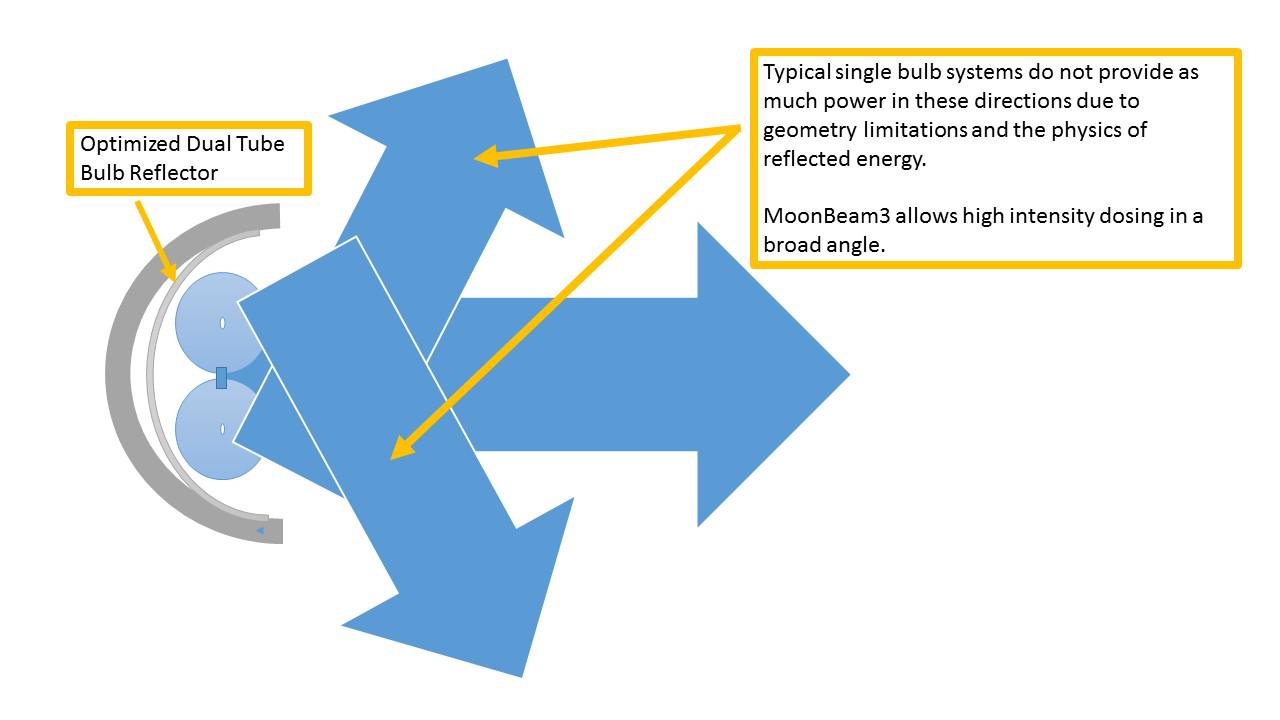
The “range” of the system is based on time allowed and the pathogens targeted. Vegetative organisms are generally more susceptible to UVC while spores require significantly more intense energy to deactivate. For maximum range, exceeding ten feet, we recommend ten minute cycles, ideally two, one on each side of a patient bed area, for example, for broadest coverage (and by default, longest range).
First, each bulb is actually a 42” long bulb folded in half, which allows us to generate power in the location, physical height, that matters most, e.g., at bed, toilet, sink height and higher, for example. Other systems with long bulbs oriented vertically may have less dose per inch of bulb to start, but also a great portion of the bulb output is located where it cannot dose the surfaces that we care about.
Second, the design of our bulb and reflectors allows the side by side location of our tubes to generate a wider dosed area than a single bulb/reflector arrangement.

The “range” of the system is based on time allowed and the pathogens targeted. Vegetative organisms are generally more susceptible to UVC while spores require significantly more intense energy to deactivate. For maximum range, exceeding ten feet, we recommend ten minute cycles, ideally two, one on each side of a patient bed area, for example, for broadest coverage (and by default, longest range).
29Will MoonBeam™3 disinfect equipment rooms?
The flexibility of the MoonBeam™3 allows use in a broad range of applications. While ultraviolet energy is generally not well suited for applications where there are many recesses and obstructions to the energy, MoonBeam™3 three heads allows multiple wide angles of dose application. Instead of a single column of light, three heads allow triangulation of the dose to a wide array of surfaces.
Download Centre
- Brochure - Download PDF
- How to Use- Download PDF
- Product Information Sheets - Download PDF
